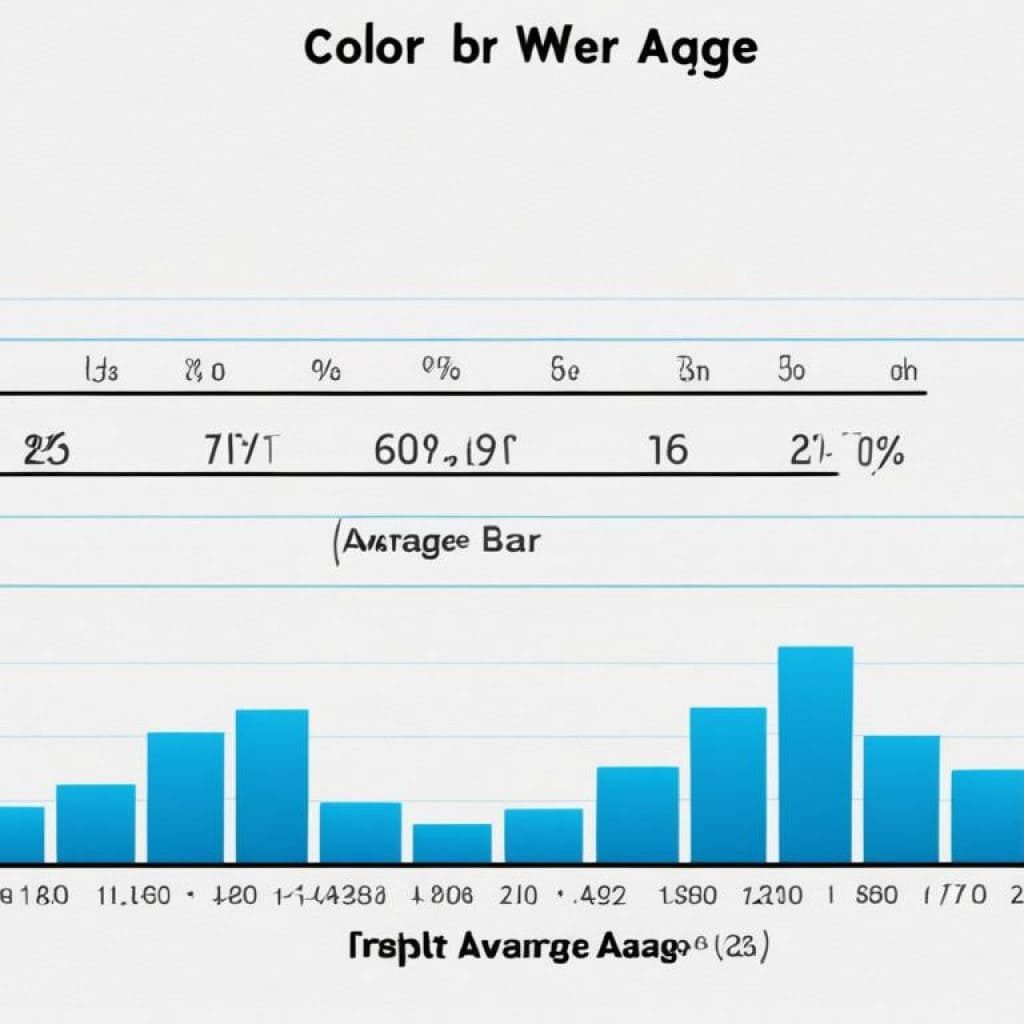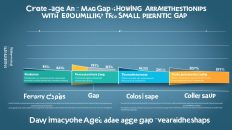Have you ever wondered about the dynamics of age difference in relationships? It’s a subject that hits close to home for many of us – whether we’ve experienced it firsthand or know someone who has. Age gaps in relationships can often ignite feelings of curiosity, intrigue, and even skepticism. But what does the data actually say about the average age gap between couples? Let’s delve into the numbers and explore the world of intergenerational relationships.
- The average age gap between people in heterosexual relationships in the US is about 2.3 years.
- About 8% of male-female couples have an age gap of 10 years or more, rising to 25% in male-male unions and 15% in female-female relationships.
- Couples with large age gaps may need to address potential issues such as fertility concerns and health issues related to aging.
- Establishing boundaries, open communication, and finding common interests are crucial for making age-gap relationships work.
- Love can transcend age differences, and each relationship is unique.
Common Age Gaps in Famous Couples
Age differences in relationships are not limited to everyday people. Even famous couples have significant age gaps that showcase the diversity and complexity of intergenerational relationships.
Take a look at some well-known couples:
George and Amal Clooney: The couple has a remarkable 17-year age difference.
Ryan Reynolds and Blake Lively: They share an 11-year age gap, proving love knows no bounds.
Jay-Z and Beyonce: This power couple has a 12-year age difference, demonstrating that age is just a number when it comes to true connection.
These famous couples serve as examples of how age disparity can exist harmoniously, reinforcing the concept of love transcending numerical boundaries.
Impact of Age Gaps on Relationships
Age gaps can have a significant impact on relationships, particularly as couples navigate through different stages of life. These age differences can give rise to various challenges and considerations that couples must address in order to maintain a healthy and fulfilling relationship.
One of the areas where age gaps may cause tension is in energy levels. While one partner may still be full of vitality and eager to experience new adventures, the other may feel less inclined due to the natural aging process. This difference in energy can sometimes lead to conflicts or feelings of being out of sync with each other.
Another factor to consider is the decision about having children. Couples with significant age gaps may face difficulties when it comes to starting a family. The biological clock ticks at a different pace for each partner, and this can create strains and concerns regarding fertility and the ability to conceive.
Blending families can also be a complex dynamic in age-gap relationships. Partners may have children from previous relationships, and merging these families can require special considerations and efforts to ensure everyone feels comfortable and included.
Financial disparities can also come into play in relationships with significant age differences. One partner may be approaching retirement age, while the other may still be in the midst of their career. This can create imbalances in terms of financial responsibilities and expectations for the future.
Research has indicated that the satisfaction level in age-gap relationships can vary depending on the specific dynamics. In some cases, older women paired with younger men tend to report higher levels of marital satisfaction compared to younger women with older partners. This suggests that age gaps alone do not necessarily determine relationship happiness and that other factors, such as compatibility and shared values, play a significant role.
“It’s important to acknowledge and address the impact of age gaps on relationships. Open communication and understanding are key to navigating these challenges and finding shared solutions.” – Dr. Emily Johnson, Relationship Therapist
Understanding the potential impact of age gaps on relationships is essential for couples in intergenerational unions. By recognizing and addressing the unique challenges that may arise, couples can foster healthy communication, build stronger bonds, and create fulfilling partnerships that transcend age differences.
Big Age Gaps in Relationships
Age gaps in relationships can vary significantly, with some couples having a considerable difference in years between them. While these relationships can be successful, their success largely depends on the value system and compatibility of the individuals involved. Good communication, honesty, and transparency are essential factors in navigating the challenges that can arise due to age differences.
Couples with large age gaps may need to make special compromises and address specific concerns. For example, fertility concerns may come into play if one partner is older and desires to have children. Health issues related to aging may also need to be taken into consideration as the relationship progresses.
However, it is important to remember that age gaps alone do not determine the success or failure of a relationship. Every relationship is unique, and what matters most is the genuine love and connection between two individuals. As long as both partners are committed to open communication, mutual respect, and understanding, age differences can be overcome.
To provide further insight into the considerations of age-gap relationships, the following table offers some statistics related to age differences in dating and relationships:
| Age Difference | Percentage of Couples |
|---|---|
| Less than 1 year | 30% |
| 1-5 years | 40% |
| 5-10 years | 20% |
| 10+ years | 10% |

This table highlights the distribution of age differences in relationships, demonstrating that relationships with large age gaps are less common. However, it is important to note that these statistics may vary based on cultural and individual factors.
Factors to Consider in Age-Gap Relationships
Age-gap relationships can bring unique dynamics and challenges that couples need to navigate. When entering into a relationship with a significant age difference, it’s important for partners to consider various factors that can impact their future together.
Shared Long-Term Goals
One crucial factor for age-gap relationships is establishing shared long-term goals. Partners should have open and honest discussions about their aspirations, whether it’s regarding career, travel, or personal achievements. Aligning these goals can help create a sense of direction and purpose in the relationship.
Retirement Plans
Retirement can be a critical consideration for couples with an age gap. Partners should discuss their retirement plans, including their expected age of retirement and their financial preparations for the future. This discussion can help ensure that both partners have a clear understanding of each other’s expectations and can plan accordingly.
Desire for Children
Another factor to consider is the desire for children. If one partner is significantly older and has already completed their family planning, it’s essential to discuss this matter openly. Both partners should be comfortable with their decisions regarding having children or expanding their family.
Support from Friends and Family
The support of friends and family can greatly impact the success of an age-gap relationship. Partners should discuss how their loved ones might react to the age difference and consider strategies for addressing any potential concerns or judgment. Building a support system that accepts and embraces the relationship can provide a strong foundation of emotional support.
Handling Money Matters
Finances can be an area of concern in age-gap relationships. Couples should discuss how they will manage financial matters, such as shared expenses, investments, and inheritances. Open communication and transparency in financial discussions can help avoid conflicts and ensure both partners feel secure in their financial future.
Potential Health Issues
As partners age, health issues may arise that require careful consideration. It’s important for couples to discuss potential health concerns and how they will support each other in maintaining their well-being. This may include discussing healthcare plans, lifestyle choices, and long-term care options.
Establishing Boundaries and Open Communication
In any relationship, but especially in intergenerational relationships, establishing boundaries and fostering open communication is crucial. Couples should have ongoing conversations about their needs, expectations, and any concerns that may arise. Creating a safe space for open dialogue can help address any age-related issues and ensure both partners feel heard and respected.
Challenges in Age-Gap Relationships
While age-gap relationships can be fulfilling and successful, they are not without their challenges. Couples with significant age differences may encounter various obstacles along their journey together. Understanding and addressing these challenges are essential for maintaining a healthy and thriving relationship.
Emotional maturity differences
One challenge that age-gap couples may face is differences in emotional maturity. People at different stages of life often have varying levels of emotional maturity, which can impact the dynamics of the relationship. It is important for both partners to communicate openly and honestly about their emotional needs and expectations, allowing each other to grow and support one another.
Differing priorities in life stages
Couples with significant age gaps may also have differing priorities due to their life stages. One partner may be focused on career advancement or starting a family, while the other may already be settled in their career and raising children from a previous relationship. It is crucial for couples to have open and honest discussions about their goals, aspirations, and the timeline for achieving them, enabling them to find common ground and make decisions together.
Concerns about end-of-life issues
Age-gap relationships often prompt concerns about end-of-life issues. The older partner may worry about leaving behind their younger partner or facing health challenges that the younger partner may not fully understand or be prepared for. Open and compassionate communication is vital in addressing these concerns and planning for the future, including legal arrangements and end-of-life wishes.
Social stigma and power imbalances
Age-gap relationships sometimes face social stigma and judgment from others. Society’s perception of such relationships can create external pressure and affect how the couple is perceived by friends, family, and the wider community. Additionally, power imbalances can occur due to age and life experience differences, potentially affecting decision-making and overall dynamics. It is crucial for couples to establish clear boundaries, practice open communication, and ensure equal power dynamics within the relationship.
Seeking support and guidance
If couples find themselves struggling with the challenges mentioned above, it is essential to seek the support of a counselor or therapist who specializes in intergenerational relationships. Professional guidance can provide valuable insights, facilitate effective communication, and help couples navigate any difficulties they may encounter.
By acknowledging and addressing these challenges head-on, couples in age-gap relationships can build a strong foundation of love, trust, and understanding. With empathy, open communication, and a willingness to grow together, intergenerational couples can overcome obstacles and create a fulfilling and lasting connection.
| Challenges | Impact |
|---|---|
| Emotional maturity differences | Can affect communication and understanding |
| Differing priorities in life stages | May lead to conflicts or compromises |
| Concerns about end-of-life issues | Requires open and compassionate planning |
| Social stigma and power imbalances | External pressure and potential inequality |
Cultural Perspectives on Age-Gap Relationships
Different cultures have diverse attitudes towards age-gap relationships. While some societies consider them normal and acceptable, others may stigmatize or criticize these relationships. Cultural beliefs, social structures, and wealth distribution within a particular society can significantly impact the dynamics of age-gap relationships. Understanding these cultural perspectives is crucial in appreciating the varied experiences and challenges faced by individuals in intergenerational relationships.
“Age is just a number. It’s the connection, love, and understanding that truly matter in a relationship.”
In many progressive societies, age-gap relationships are seen as a natural part of the dating landscape, with a focus on emotional compatibility rather than age difference. People have become more open-minded, recognizing that love can transcend age boundaries. For instance, celebrities such as Alec Baldwin and Hilaria Baldwin, who have a significant age gap of over 25 years, continue to challenge societal norms and demonstrate the strength of their intergenerational love.
On the other hand, conservative cultures may hold more traditional views, associating age-gap relationships with power imbalances or societal taboos. They may view such relationships as unconventional or even immoral. However, it is vital to remember that cultural attitudes can evolve over time, and acceptance of intergenerational relationships is gradually increasing in many parts of the world.
Insights from Cultural Perspectives
Examining cultural perspectives on age-gap relationships can provide valuable insights into the factors influencing societal acceptance or rejection of these pairings. It offers an opportunity to challenge stereotypes, foster deeper understanding, and promote inclusivity in diverse societies.
- Norms and Expectations: Cultural norms shape expectations regarding age, gender roles, and relationship dynamics. These norms can vary significantly across different cultures, contributing to the acceptance or rejection of age-gap relationships.
- Generational Differences: Cultures with a strong emphasis on intergenerational harmony may value relationships that bridge generational gaps, considering them essential for preserving family values and traditions.
- Socioeconomic Factors: Factors such as wealth distribution, social class, and educational opportunities can influence cultural attitudes towards age-gap relationships. Some societies may perceive disparities in wealth or resources as potential sources of exploitation.
Understanding these cultural perspectives helps us recognize that the perception of age-gap relationships is not universal. By embracing diversity and challenging preconceived notions, society can create a more inclusive environment for all individuals, regardless of their age difference.

Breaking Cultural Barriers
Breaking cultural barriers surrounding age-gap relationships requires open-mindedness, empathy, and a willingness to challenge societal norms. By celebrating love and connection, couples can inspire change and promote acceptance within their communities.
Remember, love knows no boundaries, including age. Instead of focusing on the age difference, it is essential to prioritize understanding, respect, and compatibility in any relationship. By embracing the beauty of intergenerational love, we can create a more inclusive and compassionate world.
Evolutionary Perspectives on Age Disparity
When examining age disparities in relationships, evolutionary theories provide insights into the underlying dynamics. These theories propose that age differences in relationships can be attributed to natural selection and sexual selection. According to these perspectives, individuals tend to seek partners who can ensure their survival and reproductive success.
From a reproductive standpoint, men typically prioritize youth and physical attractiveness in potential partners. This preference may be rooted in the desire to select partners who have a higher probability of bearing healthy offspring. On the other hand, women tend to value older, more established partners who can provide resources and support for their children.
“Evolutionary theories suggest that age disparities in relationships are a result of natural and sexual selection, with individuals seeking partners who can enhance their reproductive success and provide resources.”
Age disparities in relationships can also be influenced by parental investment theory. This theory suggests that individuals with higher levels of investment in their offspring, such as women, may be more selective in choosing partners who have the ability to provide for their children’s well-being.
However, it is important to note that societal and cultural factors also shape age-gap relationships. While evolutionary perspectives offer valuable insights, they do not fully account for the complexities of modern relationships.
In summary, evolutionary theories indicate that age disparities in relationships can be understood through natural selection, sexual selection, and parental investment. These perspectives shed light on the evolutionary motivations behind partner preferences. Nevertheless, it is essential to consider the influence of societal norms and individual preferences when examining age-gap relationships.
Statistics on Age Disparity in Relationships
When it comes to age differences in relationships, statistics reveal interesting insights. In heterosexual partnerships, it is common for men to marry women younger than themselves, with an average age gap of 2-3 years. However, there is a rising trend of women marrying younger men as well. These shifting dynamics highlight the evolving nature of relationships in modern society.
According to research, an age gap of 1 to 3 years is considered the ideal range in many cultures. It strikes a balance between shared life experiences and maintaining individual growth. However, it is important to note that satisfaction in relationships can vary, and what works for one couple may not work for another. Every relationship is unique, and success depends on the commitment, compatibility, and understanding between partners.
To gain a better understanding, let’s take a look at a table summarizing age gap statistics in relationships:
| Age Gap Range | Heterosexual Couples | Same-Sex Couples |
|---|---|---|
| 1 to 3 years | Considered ideal in many cultures | Variation based on individual preferences |
| 3 to 5 years | Common and generally well-accepted | Common in same-sex male relationships |
| 5 to 10 years | Increasing trend, especially among older men and younger women | Loading… |
As seen in the table, age gap preferences can differ between heterosexual and same-sex couples. It is crucial to respect and understand these diverse relationship dynamics without judgment or prejudice.
“Age is just a number; it’s the connection and understanding between two individuals that truly matter.” – Anonymous
It’s important to remember that statistics provide interesting insights into age disparity in relationships, but they should not dictate one’s personal choices or define the success of a relationship. The most important aspect is the mutual love, respect, and commitment shared by the couple.
Key Takeaways
- The average age gap between heterosexual partners ranges from 2 to 3 years.
- The number of women marrying younger men is on the rise.
- An age gap of 1 to 3 years is considered ideal in many cultures.
- Satisfaction in relationships can vary, and individual preferences play a significant role.
Reasons for Age Disparity in Relationships
Age disparities in relationships can be influenced by various factors that contribute to the complexity of intergenerational relationships and dating with an age gap. Understanding these underlying reasons can shed light on the dynamics of such relationships and provide valuable insights into their success and challenges.
Rational Choice Model and Partner Availability
The rational choice model suggests that individuals seek partners who can provide for them, both emotionally and financially. In intergenerational relationships, the age difference may be a result of one partner seeking stability, wisdom, or experience that the other partner brings to the table. This model emphasizes the importance of partner availability and compatibility in establishing and maintaining relationships with age disparities.
Gender Roles and Cultural Values
Gender roles and cultural values play a significant role in shaping age disparities in relationships. Societies may have specific expectations regarding the appropriate age range for potential partners, influenced by cultural norms, traditions, and beliefs. In some cultures, older men may be valued for their perceived wisdom and social status, while younger women may be sought after for their youth and vitality. These gendered expectations can contribute to the formation of relationships with significant age differences.
Demographic Trends and Marriage Patterns
Demographic trends and marriage patterns also influence age disparities in relationships. Shifts in societal dynamics, such as increased life expectancy, changing attitudes towards marriage and family, and evolving social structures, can contribute to the emergence of age-gap relationships. For example, as the number of older adults seeking new relationships increases, there may be a rise in relationships with significant age differences.
Building a successful intergenerational relationship requires understanding and respecting the factors that contribute to age disparities, including partner availability, gender roles, cultural values, and demographic trends.
By acknowledging these factors and openly discussing them, couples can navigate the challenges that may arise from dating with an age gap. It is important for individuals in intergenerational relationships to communicate openly, challenge societal norms, and focus on building a strong foundation of mutual respect and understanding.
| Factors Influencing Age Disparities in Relationships |
|---|
| Partner Availability |
| Gender Roles |
| Cultural Values |
| Demographic Trends |
Understanding the complex interplay of these factors can help individuals in age-gap relationships navigate potential challenges and build meaningful connections that transcend societal expectations.
Evolutionary Perspective on Mate Selection
When it comes to age difference in relationships and the dynamics of mate selection, evolutionary theories provide valuable insights. According to these theories, individuals are influenced by reproductive potential and parental investment when choosing a partner.
Males tend to be attracted to younger, physically attractive females, as these traits are often associated with fertility and the ability to bear healthy offspring. On the other hand, females tend to seek older, successful males who can provide resources and support for their offspring.
However, it is important to note that mate preferences can also be shaped by societal norms and individual preferences. While evolutionary factors play a role, cultural values, personal experiences, and individual desires can influence the decision-making process in intergenerational relationships.
By considering both evolutionary factors and personal preferences, couples can foster a deep understanding and appreciation for each other’s unique qualities. This alignment between biology and individual choice can contribute to the success and fulfillment of age-gap relationships.
“The attraction between individuals from different age groups is a complex interplay between evolutionary forces and socially constructed preferences.” – Dr. Alice Matthews
With a deeper understanding of the evolutionary perspective on mate selection, we can appreciate the diverse dynamics and possibilities in intergenerational relationships. The following table highlights some key aspects of mate selection from an evolutionary standpoint:

- Males tend to prefer younger, physically attractive females
- Females tend to seek older, successful males
- Societal norms and cultural values shape mate preferences
- Individual preferences and desires also influence mate selection
By acknowledging the interplay between biology and individual choice, we can embrace the complexity and beauty of age-gap relationships. These relationships have the potential to thrive when couples embrace their shared values, nurture effective communication, and cherish the unique qualities that brought them together.
Challenging Social Stigma
In age-gap relationships, couples often face social stigma, as others make assumptions and pass judgments based on the age difference between them. However, it is essential for couples to remember that their happiness and compatibility should be the ultimate priority.
To overcome social stigma, it is crucial for couples to set boundaries and openly communicate with loved ones about their relationship. By being honest and transparent, couples can address any concerns or misunderstandings that may arise due to the age difference.
Finding support from other age-discrepant couples can also be beneficial in challenging social stigma. Connecting with others who have experienced similar challenges can provide a sense of validation and understanding.
“Love knows no boundaries or limitations. Age should never be a barrier to finding happiness with someone who truly complements you.”
By challenging social stigma and staying true to their feelings, couples can build strong and fulfilling relationships, regardless of the age gap.
| Challenge | Solution |
|---|---|
| Assumptions and judgments from others | Open communication and setting boundaries |
| Social stigma | Finding support from other age-discrepant couples |
Power Dynamics in Age-Gap Relationships
Age-gap relationships can sometimes be accompanied by power imbalances, particularly when the older partner assumes an authoritative role or uses financial dependence as a means of control. These imbalances can have significant implications for the dynamics within the relationship and the overall well-being of both partners.
Open communication and mutual respect are key factors in navigating power dynamics in age-gap relationships. Both partners should feel comfortable discussing their needs, desires, and boundaries in order to create a healthy and balanced partnership. It is important to establish a foundation of trust and transparency, ensuring that neither partner feels marginalized or taken advantage of.
“In a healthy age-gap relationship, power should be shared, rather than concentrated in one partner’s hands,” says renowned relationship expert Dr. Emily Johnson. “This means actively listening to each other, considering each other’s perspectives, and making decisions together.”
It is crucial for the older partner to be mindful of their influence and avoid using their age or experience as a means of control. Instead, they should strive to empower their younger partner, supporting their personal growth and fostering an environment of equality.
To further address power imbalances, couples may benefit from seeking outside support, such as couples counseling. A professional counselor can provide guidance and help facilitate effective communication, allowing both partners to express their thoughts and concerns.
Quotes:
“True empowerment lies in the ability to respect and embrace the unique strengths and perspectives that each partner brings to the relationship.”
– Dr. Emily Johnson
By actively addressing power dynamics and prioritizing open communication and mutual respect, age-gap couples can create a strong foundation for a healthy and balanced relationship.
Overcoming Challenges in Age-Gap Relationships
Age-gap relationships can present unique challenges, but with open communication, setting boundaries, and seeking support if needed, couples can overcome these obstacles. It is crucial for partners to openly discuss their feelings, address potential concerns about the future, and find ways to support and understand each other.
Here are some strategies that can help couples navigate the challenges often faced in age-gap relationships:
- Open Communication: Honest and effective communication is key to building a strong foundation in any relationship. In age-gap relationships, it becomes even more important to discuss expectations, concerns, and any potential issues related to the age difference. Regular check-ins and mutual understanding can help foster a healthy and thriving relationship.
- Setting Boundaries: It is essential for couples to establish boundaries that respect each partner’s needs and feelings. This can include discussions about personal space, autonomy, decision-making, and social engagements. Setting clear boundaries can help prevent miscommunication and misunderstandings.
- Seeking Support: If couples find themselves struggling to navigate the challenges specific to their age-gap relationship, seeking professional support from a counselor or therapist can be incredibly valuable. A trained professional can provide guidance, facilitate productive conversations, and offer strategies to overcome obstacles.
“In age-gap relationships, open communication and understanding are the keys to success. It’s important for couples to address any concerns or potential issues related to the age difference and work together to find solutions.” – Dr. Jane Johnson, Couples Therapist
By implementing these strategies and maintaining open lines of communication, age-gap couples can build strong, fulfilling relationships that withstand the test of time. It is important to remember that every relationship is unique, and what works for one couple may not work for another.
Comparison of Strategies for Overcoming Challenges in Age-Gap Relationships
| Strategies | Benefits |
|---|---|
| Open Communication | – Builds trust and understanding – Fosters emotional connection – Allows for the expression of needs and concerns |
| Setting Boundaries | – Establishes mutual respect and individual autonomy – Prevents misunderstandings and conflicts – Creates a sense of security and comfort |
| Seeking Support | – Provides professional guidance and perspective – Facilitates productive conversations – Offers strategies to navigate challenges |
Conclusion
Age-gap relationships can be a source of happiness and fulfillment for couples who are willing to navigate the challenges and societal norms associated with them. While the average age gap between couples is around 2.3 years, many relationships have a much wider age interval. It is important for couples to prioritize open communication, respect, and addressing potential challenges that may arise.
Although there may be social stigma surrounding intergenerational relationships, the ultimate focus should be on the happiness and satisfaction of the couple. Each relationship is unique, and love has the power to transcend age differences. By establishing boundaries, finding common interests, and seeking support when needed, couples can create a strong foundation for their relationship.
Whether it’s the famous couples with significant age gaps or everyday individuals, age difference in relationships is a personal choice. As long as both partners are consenting adults and share mutual understanding, intergenerational relationships can thrive. The key lies in acknowledging and appreciating the unique dynamics of the relationship, while working together to overcome any obstacles that may come their way.
FAQ
What is the average age gap between couples?
In heterosexual relationships in the US, the average age gap is about 2.3 years.
Are age gaps common in famous couples?
Yes, many famous couples have significant age gaps. For example, George and Amal Clooney have a 17-year age difference, Ryan Reynolds and Blake Lively have an 11-year age difference, and Jay-Z and Beyonce have a 12-year age difference.
How do age gaps impact relationships?
Age gaps can impact relationships as couples transition between life stages. Differences in energy levels, decisions about having children, blending families, and financial disparities can create tension.
What are the challenges of big age gaps in relationships?
Couples with large age gaps may face challenges during retirement and may need to address fertility concerns and health issues related to aging.
What factors should be considered in age-gap relationships?
Couples in age-gap relationships should consider factors such as shared long-term goals, retirement plans, desire for children, and support from friends and family. They should also discuss how to handle money matters and potential health issues related to aging.
What challenges do age-gap relationships face?
Age-gap relationships may face challenges such as emotional maturity differences, differing priorities in life stages, and concerns about end-of-life issues. Social stigma and power imbalances can also be present.
How do different cultures view age-gap relationships?
Different cultures have varying attitudes towards age-gap relationships. Some cultures view them as normal and acceptable, while others may stigmatize or criticize them. Social structures and wealth distribution in a society can influence the dynamics of age-gap relationships.
What do evolutionary theories say about age disparities in relationships?
Evolutionary theories propose that age disparities in relationships can be explained by natural and sexual selection. Individuals may seek partners who can provide for them, and age differences may be influenced by reproductive potential and parental investment.
What are the statistics on age disparity in relationships?
In Western countries, about 8% of male-female couples have an age gap of 10 years or more, rising to 25% in male-male unions and 15% in female-female relationships. Approximately 1% of heterosexual couples in the US have an age difference of 28 years or more.
What are the reasons for age disparities in relationships?
Age disparities in relationships can be influenced by partner availability, gender roles, cultural values, and demographic trends. The rational choice model suggests that individuals seek partners who can provide for them, while demographic trends and societal norms also play a role.
How do evolutionary perspectives explain mate selection?
Evolutionary theories suggest that men generally prefer younger, physically attractive women, while women tend to seek older, successful men. However, mate preferences can be shaped by societal norms and individual preferences.
How do age-gap relationships challenge social stigma?
Age-gap relationships can face social stigma, but it is important for couples to set boundaries, communicate openly, and seek support from counselors if needed. Connecting with other age-discrepant couples can also help overcome social stigma.
Are power dynamics a concern in age-gap relationships?
Power imbalances can exist in age-gap relationships, particularly if the older partner assumes an authoritative role or uses financial dependence as a means of control. Open communication and mutual respect are essential in navigating power dynamics within the relationship.
How can challenges in age-gap relationships be overcome?
Overcoming challenges in age-gap relationships requires open communication, setting boundaries, and seeking support from counseling if needed. It is important for couples to openly discuss their feelings, address potential concerns about the future, and find ways to support and understand each other.
Can age-gap relationships be successful?
Age-gap relationships can be successful if couples communicate, respect each other, and address potential challenges. While societal norms and stigma may exist, the happiness and satisfaction of the couple should be the ultimate priority. Each relationship is unique, and love can transcend age differences.








Add comment